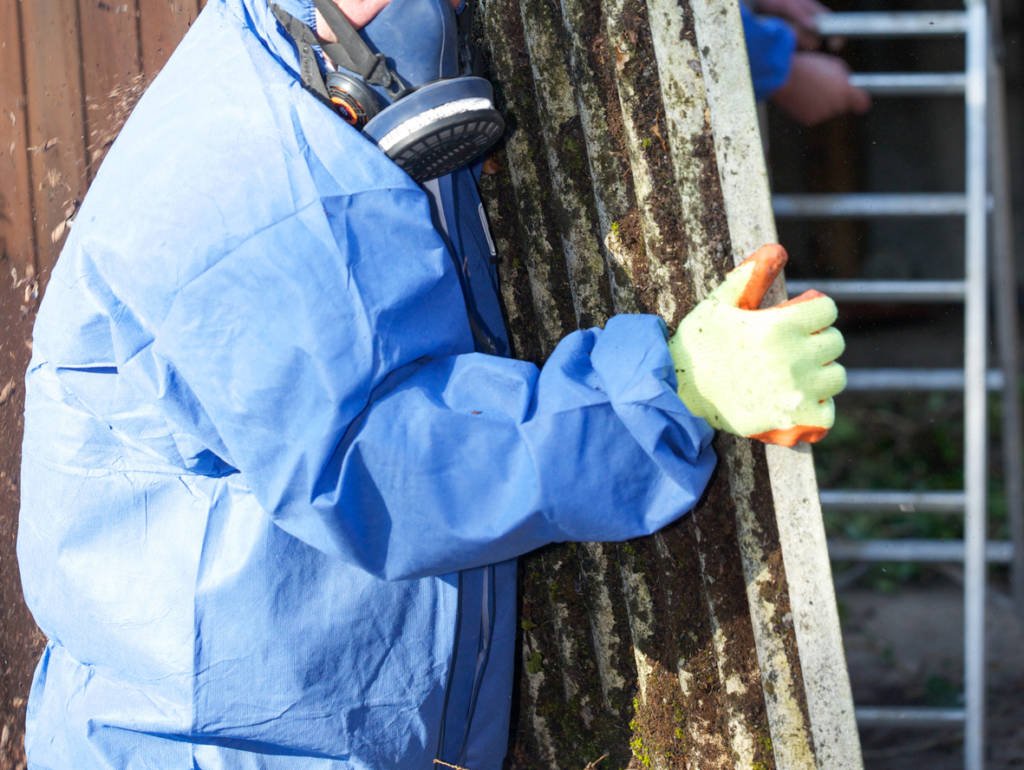Your Complete Guide to Hiring an Asbestos Abatement Company

Asbestos is a naturally occurring mineral that’s heat resistant. It’s composed of flexible fibers that make it advantageous for insulation. However, because it is also highly toxic, it has been strongly regulated in the U.S. since the 1970s (prior to that it was used in excess).
It’s extremely important to take asbestos seriously and to exercise extreme caution in any situation presents a risk of exposure. Asbestos exposure can lead to serious health complications, including respiratory diseases and certain types of cancer. Asbestos abatement should be handled by professionals. A professional will conduct a visual inspection and may take samples to be analyzed in a laboratory. During the abatement process, a variety of safety and preventative measures must be put in place to protect from airborne asbestos exposure.
Today, products may only contain asbestos at concentrations of less than 1%. Any product containing more than 1% is categorized as asbestos-containing material or ACM. In this blog post, we will refer to ACM products as asbestos products.
Asbestos 101
What Does Asbestos Abatement Mean?
Why Is Abatement Important
Understanding the Dangers of Asbestos
Common Asbestos-Containing Materials in Buildings
Reasons to Test a Structure for Asbestos
Steps to Take If You Suspect Contamination
Tips for Hiring an Asbestos Abatement Company
Asbestos Abatement Cost
Site Preparations for Asbestos Removal
How to Handle and Remove Asbestos
How to Dispose of Asbestos After Abatement
Common Asbestos Abatement Equipment
FAQs
Asbestos 101
Because of its durability and fire-resistant properties, many buildings built prior to the 1980s contain asbestos products. Asbestos can also be found in boilers and pipes, flooring materials, cement, textured paints, roofing shingles, and automobile parts. Although manufacturing products with asbestos isn’t illegal, it is highly regulated, and The United States Environmental Protection Agency (EPA) and the U.S. Consumer Product Safety Commission (CPSC) have banned several asbestos products, as the mineral can cause serious health problems, like mesothelioma and asbestosis, a non-cancerous progressive lung disease.
There are two types of asbestos:
- Friable material – A lose matrix that allows dust particles to easily be released into the air with light hand pressure. Only professionals should handle friable material.
- Non-friable material – Material that is not friable until sanded, cut, or scratched in any way. Non-friable material, when undisturbed, does not pose a health risk if it remains in its current state.
What Does Asbestos Abatement Mean?
Asbestos abatement is the process of removing any contaminated materials containing asbestos from a site. It’s often used interchangeably with asbestos removal and remediation, but they are different elimination processes.
Asbestos removal is the removal of the asbestos, which may include contaminated materials.
Asbestos remediation is the elimination of the contaminated material and identifying and removing the source of the contaminant.
Why Is Abatement Important?
Abatement is important for many reasons, mainly health-related risks. Since symptoms of asbestos exposure can take up to 14 years to develop, it’s important to keep an eye out in old homes, especially during renovations or remodels.
Unlike mold, you can’t smell asbestos. In most cases, exposure only occurs when the material that contains asbestos is disturbed or damaged in some way, which can release particles and fibers into the air, according to the EPA.
Removal processes also depend on whether the asbestos is friable or nonfriable. Since friable asbestos can be easily crumbled and released into the air, this material should only be handled by a professional.
Asbestos Removal Regulations
Asbestos removal regulations vary by state. In New Hampshire, for example, homeowners in a single-family, owner-occupied home may remove asbestos. However, they are legally required to use an asbestos abatement company for proper disposal. In Massachusetts, all asbestos must be removed and disposed of by an abatement contractor. It’s best to contact your state’s Department of Environmental Services / Protection division for information regarding removal criteria.
Understanding the Dangers of Asbestos
Asbestos Exposure
Inhaling or ingesting asbestos can lead to serious health issues such as mesothelioma, lung cancer, asbestosis, and pleural plaques. Mesothelioma is a non-curable tumor that forms in the lungs, abdomen, or heart due to asbestos exposure. Any individual or family member of an individual diagnosed with mesothelioma may be eligible for compensation. When many asbestos manufacturers filed for bankruptcy, they created asbestos trust funds that compensate mesothelioma sufferers and individuals with other asbestos-related diseases.
Common Asbestos-Containing Materials in Buildings
Asbestos can be found in the following places:
- Floor tiles and sheet flooring
- Mastic (adhesive or glue)
- Pipe and boiler insulation
- Roofing and siding materials
- Joint Compound an wall surfacing materials (including popcorn ceilings)
- Fireproofing materials
- Glazing and caulking compounds
- Vermiculite insulations (Zonolite)
Reasons to Test a Structure for Asbestos
If a structure was built prior to 1970, and renovations or new construction is planned, you may be required to tested for asbestos. In many New England states it’s a requirement to test for asbestos and other potentially hazardous materials – even if the home was built after the 1970’s.
It’s important to test before construction because there may be non-friable asbestos present that will become friable during the construction process. When asbestos becomes friable, it becomes a health risk to anyone in the building.
Steps to Take If You Suspect Contamination
If you suspect contamination, it’s important to act in a timely manner. If possible, steer clear of the contaminated area. Contact an asbestos testing company for a consultation and for more information on the removal process.
Tips for Hiring an Asbestos Abatement Company
It’s important to hire a reputable company for asbestos abatement. In addition to following all regulations and ordinances, you want to make sure the company does a thorough and safe job. Here are a few questions to consider when looking to hire an asbestos abatement company:
- Are you license to perform abatement in my state?
- How many licensed supervisors & workers do you have?
- Do you perform multiple services?
- Have you done this type of removal in the past?
- How much experience does the company have?
- Are there any testimonials on their website?
Asbestos Abatement Cost
The average cost of asbestos abatement for a residential project is around $2,500-$10,000, but it’s important to remember that not all removal projects are the same.
There are many factors that will affect asbestos removal cost, including:
- Location of asbestos within the home or structure
- Amount and condition of the asbestos
- Location of the job itself
Site Preparations for Asbestos Removal
Once you’ve had an inspection and hire a removal company, you’ll need to help clear the area and prepare for the removal.
Clear the Area
The homeowner is generally responsible for clearing counters or other surfaces around the contaminated area if the contents have not been contaminated by asbestos. It’s fine to leave items in cabinets.
Build a Containment Zone
The abatement contractor will build a containment area around the asbestos by hanging sheets of poly sheeting (plastic). The contractor will also cover critical barriers, such as windows, doors, and HVAC openings that are not being used. Most states require that the work zone be placed under negative air pressure using HEPA rated equipment. These devices will help reduce the risk of cross-contamination outside of the work zone.
Construct a Decontamination Unit
The abatement company will build three chambers: a clean room, shower, and dirty room. This will help keep the process safe and effective.
How to Handle and Remove Asbestos
Asbestos should be handled and removed by a professional. It’s illegal in many states for unlicensed people to handle and remove asbestos. If you’re considering removing asbestos yourself, you should consult your state’s regulations. If you’re uncertain if you have the right equipment or can remove the asbestos safely, it’s best to call an abatement company that can do it properly.
How to Dispose of Asbestos After Abatement
Since asbestos is a hazardous substance, it must be deposed of properly. Disposal requires waste to be sealed in a clearly labeled, leak-free containers while still wet. It is then taken to a qualified landfills that has specific requirements for securing the waste safely. Transport vehicles may also have specific requirements and labeling instructions. Some asbestos abatement firms have a license to accept asbestos waste. If you have a small quantity, you may want to inquire if they will accept it.
Common Asbestos Abatement Equipment
Common equipment includes:
- HEPA vacuum or HEPA filtered negative air machines
- Personal protective equipment (PPE). This will include:
- Respirator
- Eyewear
- Disposable Gloves
- Disposable overalls
- Rubber boots
- Decontamination chambers
- Small hand tools
- Properly labeled trash bags
FAQs
Q: How do I know if I need abatement?
A: If you’re unsure if you need abatement, it’s smart to contact a certified inspector to either confirm or deny asbestos containing material (ACM). If you are planning on renovating your house, or removing asbestos by yourself, it’s important to familiarize yourself with federal and local laws regarding inspections, removal, and disposal.
Q: Can I remove asbestos myself?
A: That depends on your state and local regulations.
Q: How long does the removal process take?
A: The removal process length will depend on the location and extend of the asbestos. It can take be as short as few hours or as long as a few weeks. For example, it could take a few hours to remove a small amount of pipe insulation, but a few weeks to remove a large amount of insulation from a home.
Q: Why is it important to handle asbestos safely?
A: Asbestos exposure can lead to serious health complications, including respiratory diseases and certain types of cancer.
Q: Why hire an asbestos abatement company?
A: Since asbestos is so dangerous, it’s important that the abatement process is done safely by trained, experienced professionals and that all of the asbestos is removed.
Q: How long after asbestos removal is it safe to enter my house?
A: It’s safe to enter your house after the removal process and clearance testing has been completed, and the containment zone is deconstructed. Most states require some form of clearance testing once the work is complete before the equipment and barriers are removed. These tests are performed by licensed Industrial Hygienists and are not affiliated with the abatement contractor. This is a 3rd party verification that the asbestos has been removed and that the work zone is not contaminated with asbestos dust. Many times, an air sample is required before the barriers and equipment can be removed. The analysis of the air sample is usually performed on site.
Q: What Is the difference between friable and nonfriable asbestos?
A: Friable asbestos can easily crumble with a light touch and release dangerous particles into the air. Non-friable materials are not a health risk in their current state, but when sanded, cut, or scratched, can become friable.
EnviroVantage is a highly trusted national and regional contractor with offices throughout New England and the Mid-Atlantic. As an industry leader with more than 35 years of award-winning experience, we handle asbestos abatement for both residential and commercial projects and can take on any project, no matter the size.
If you have questions about asbestos removal or would like to speak with one of our specialists, please contact us today.

Are you ready to buy or sell your home?
Whether your offer has just been received or you’re thinking about putting your house up for sale, consider these 15 important questions to ask your home inspector.

Questions?
We’d be happy to answer them — and talk about how EnviroVantage can support your next abatement, demolition, or remediation project.